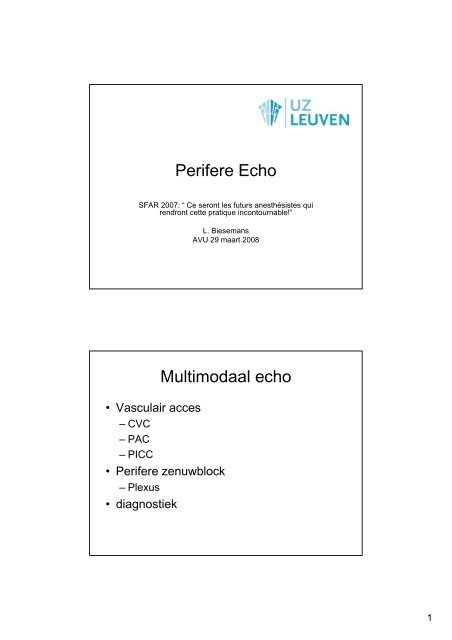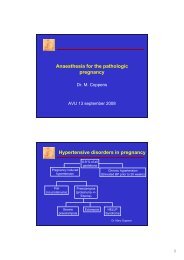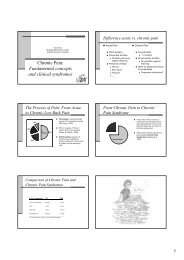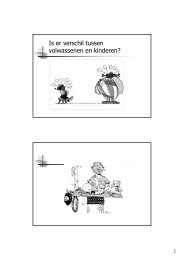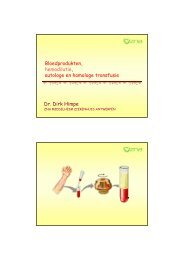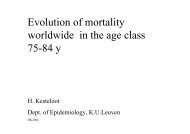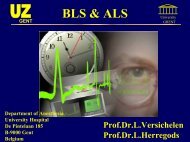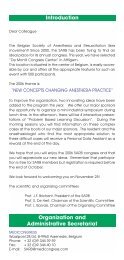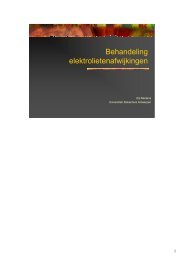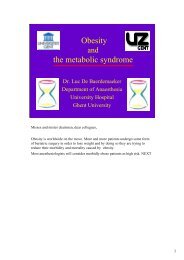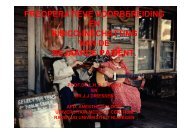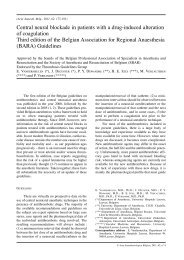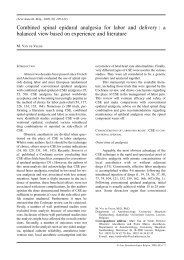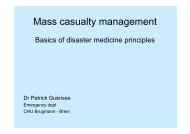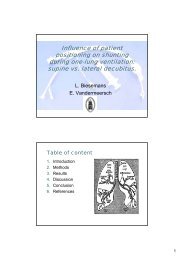Perifere Echo Multimodaal echo
Perifere Echo Multimodaal echo
Perifere Echo Multimodaal echo
You also want an ePaper? Increase the reach of your titles
YUMPU automatically turns print PDFs into web optimized ePapers that Google loves.
<strong>Perifere</strong> <strong>Echo</strong><br />
SFAR 2007: “ Ce seront les futurs anesthésistes qui<br />
rendront cette pratique incontournable!”<br />
• Vasculair acces<br />
–CVC<br />
– PAC<br />
–PICC<br />
L. Biesemans<br />
AVU 29 maart 2008<br />
<strong>Multimodaal</strong> <strong>echo</strong><br />
• <strong>Perifere</strong> zenuwblock<br />
–Plexus<br />
• diagnostiek<br />
1
History <strong>echo</strong>grafie<br />
• 1822: D. Colladen: berekening snelheid van geluidsverplaatsing in water<br />
• 1880: P. Curie: piëzzoelectrische eigenschappen kristallen<br />
• 1912: SONAR<br />
• 1915: P. Langevin: hydrophone<br />
• 1940: K. Dussik: <strong>echo</strong> hersenen… zonder veel succes<br />
• 1949: J. Wild: <strong>echo</strong> weefsels<br />
<strong>Echo</strong>grafie principe<br />
Tim Royer, 2001 – Nadine Nagazawa 2006<br />
2
Belangrijk te weten<br />
• Lineaire probe<br />
– Smalle scanning zone (1 mm)<br />
• Hogere frequentie (8-12 MHz)<br />
– Betere resolutie<br />
– Minder diepte<br />
• Lagere frequentie<br />
– Minder resolutie<br />
– Grotere diepte<br />
• Doppler voor differentiatie vaten<br />
• Venen = samendrukbaar<br />
• Arteries = pulsatiel<br />
Prof. M. Stas<br />
Hoe werkt het?<br />
De <strong>echo</strong>-probe thv het<br />
huidoppervlak loodrecht<br />
boven de vene houden,<br />
op 90°<br />
➙ de afstand tussen<br />
probe en vene =<br />
afstand tussen naald en<br />
probe bij de punctie.<br />
Hier, wordt de naald met<br />
een hoek van 45°<br />
gehouden en komt in de<br />
vene op 1.5cm diep.<br />
Probe<br />
Vein<br />
Needle<br />
Nadine Nagazawa<br />
3
<strong>Echo</strong>-beeld op het scherm<br />
Waarom <strong>echo</strong>?<br />
Nadine Nagazawa<br />
• Veiliger voor patient: complicaties<br />
– Abnormale anatomie<br />
– Obesitas<br />
– Deformiteit / rigiditeit / heelkunde halsregio<br />
– Hypovolemie<br />
– Pt kan niet plat liggen / trendelenburg slecht verdagen<br />
– Flow - doorgangkelijkheid bloedvat (thrombus)<br />
– Anatomische evaluatie target area voor cannulatie en tijdens punctie /<br />
beter overzicht anatomie<br />
– Coagulopathie / thrombopenie<br />
– Veelvuldige voorgaande puncties<br />
– Voorkomt onnodige puncties (afwezige vene, vene niet open,…)<br />
• Teaching<br />
• Medicolegaal<br />
• Beter voor firma’s…<br />
4
Complicaties bij « blinde » punctie voor CVC<br />
Arteriele punctie<br />
Pneumothorax<br />
Hematoma<br />
Totaal<br />
Jugularis<br />
interna (%)<br />
6.3 – 9.4<br />
< 0.1 – 0.2<br />
< 0.1 – 2.2<br />
6.3 – 11.8<br />
Merrer J, JAMA 2001<br />
Sznajder JI, Arch Intern Med 1986<br />
Mansfield PF, NEJM 1994<br />
Martin C, Crit Care Med 1997<br />
Durbec O, Crit Care Med 1997<br />
Timsit JF, Ann Intern Med 1999<br />
Subclavia<br />
(%)<br />
3.1 – 4.9<br />
1.5 – 3.1<br />
1.5 – 3.1<br />
6.2 – 10.7<br />
Femoraal<br />
(%)<br />
9.0 – 15.0<br />
NA<br />
NA<br />
12.8 - 19.4<br />
Contra<br />
• Deskill traditional practitioners of ancient<br />
art<br />
• Trainees will no longer learn old<br />
techniques<br />
• Time consuming<br />
•Ittakestwo<br />
• Availability of equipment<br />
• Not of much use in experienced operators<br />
• Cost / sterility<br />
• Long learning curve<br />
5
NICE<br />
• http://www.nice.org.uk 2002<br />
• Guidance on the use of ultrasound<br />
locating devices for placing central venous<br />
catheters. Technology Appraisal Guidance<br />
No 49, September 2002<br />
• Hind, BMJ 2003; 227-365<br />
– Ultrasonic locating devices for central venous<br />
cannulation: meta-analysis<br />
Meta-analysis: Hind, BMJ 2003<br />
n Comparison of guidance using real-time 2-D<br />
ultrasonography vs anatomical landmark techniques : 18<br />
randomised controlled trials (1649 pts), 3 studies in infants<br />
• 2-D ultrasonography :<br />
– Internal jugular vein : significantly lower failure rate both overall<br />
(relative risk 0.14, 95% confidence interval 0.06 to 0.33) and on<br />
the first attempt (0.59, 0.39 to 0.88)<br />
– Limited evidence favoured two dimensional ultrasound guidance<br />
for subclavian vein and femoral vein procedures in adults<br />
6
<strong>Echo</strong>-geleide punctie<br />
<strong>Echo</strong>-geleide punctie<br />
Dr Desruennes, IGR<br />
Dr Desruennes, IGR<br />
7
<strong>Echo</strong>-geleide punctie<br />
Punctie vena jugularis interna: <strong>echo</strong>!<br />
Met dank aan Dr Desruennes<br />
Normale VJI Atrofische VJI<br />
Met dank aan Dr Le Donne<br />
Trombose VJI<br />
8
Dr Desruennes, IGR<br />
Aanpriknaald parallel met probe<br />
«tip-<strong>echo</strong>»<br />
Repetitie <strong>echo</strong>’s Dr Desruennes, IGR<br />
9
Aanpriknaald parallel met probe<br />
Dr Desruennes, IGR<br />
Aanpriknaald loodrecht op sonde<br />
«tip-écho »<br />
Dr Desruennes, IGR<br />
10
Belangrijk: naaldtip in beeld houden<br />
Dr Desruennes<br />
+<br />
Lengte van naald zichtbaar<br />
Ingangsplaats minder belangrijk<br />
-<br />
Naald en probe MOETEN altijd<br />
parallel blijven<br />
+<br />
Eenvouding<br />
Milieu de la sonde = axe de<br />
ponction (simple)<br />
-<br />
Geen keuze voor ingangsplaats<br />
Probe bewegen op naaldtip te<br />
volgen<br />
Dr Desruennes, IGR<br />
11
Voorbeelden<br />
Schildklier cysten Trombus<br />
Klieren<br />
Punctie vena subclavia<br />
Trombus<br />
(Doppler)<br />
Carotis postero-lateraal<br />
Dr Desruennes, IGR<br />
Dr. M. Bunodière<br />
12
Vena subclavia: supra of infraclaviculaire benadering<br />
Probe, naald en vene zijn longitudinaal<br />
needle<br />
subclavian vein<br />
Dr Desruennes, IGR<br />
Supraclaviculaire benadering van de vena<br />
subclavia<br />
Dr Desruennes, IGR<br />
13
Infraclaviculaire benadering van de vena<br />
subclavia<br />
Dr Desruennes, IGR<br />
14
Bailey et al.: A survey of the use of ultrasound<br />
during central venous catheterisation.<br />
Anesth Analg. 2007<br />
• Evaluate frequency of and factors<br />
influencing US use<br />
• Members of Society of Cardiovascular<br />
Anesthesiologists<br />
– n=4235<br />
• Responders: 35%<br />
– n=1494<br />
70<br />
60<br />
50<br />
40<br />
%<br />
30<br />
20<br />
10<br />
0<br />
67<br />
never use<br />
US<br />
15<br />
always use<br />
US<br />
33<br />
no acces<br />
to US<br />
41<br />
acces to<br />
US<br />
15
CONCLUSIONS:<br />
• Availability of US equipment was strongly<br />
associated with use for CVC<br />
• Most common reason for not using US:<br />
– “no apparent need for the use of US”: 46%<br />
• Current use of US during CVC differs from<br />
existing evidence-based recommendations<br />
Karakitsos et al.: Critical care 2006<br />
• Is real-time ultrasound-guided cannulation<br />
of the internal jug. vein superior to<br />
standard landmark method?<br />
• Randomised study<br />
• n = 900<br />
• Critical care unit<br />
• Physicians with comparable experience<br />
16
Outcome measures Ultrasound group<br />
(n=450)<br />
Acces time (seconds) 17.1±16.5 44±95.5<br />
Landmark group<br />
(n=450)<br />
Succes rate 450 (100%) 425 (94.4%)<br />
Carotid puncture 5 (1.1%) 48 (10.6%)<br />
Haematoma 2 (0.4%) 38 (8.4%)<br />
Haemothorax 0 (0%) 8 (1.7%)<br />
Pneumothorax 0 (0%) 11 (2.4%)<br />
Average number of<br />
attempts<br />
1.1±0.6 2.6±2.9<br />
CVC-BSI 47 (10.4%) 72 (16%)<br />
Conculsion<br />
• US catheterisation of int. Jug. Vein in crit. Care<br />
patients is superior to landmark technique<br />
• The visualisation of the IJV and of neighboring<br />
anatomical structures on both the longitudinal<br />
and transverse axes ensures the avoidance of a<br />
double-wall puncture during catheterisation<br />
• US-guided cannulation of the IJV<br />
– offers the advantage of a shorter acces time and a<br />
reduced number of attempts to succeed<br />
– Has a lower mechanical complication rate and may<br />
result in a lower incidence of CVC-BSI compared with<br />
the landmark technique<br />
17
Bias?<br />
• Landmark: punctieplaats optimaal?<br />
• Performer: anesthesist? Intensivist?<br />
• Bij prikken m.b.v. <strong>echo</strong> wordt de “aan te<br />
prikken vene” eerst geëvalueerd, zo nodig<br />
punctie aan contralaterale kant<br />
PICC<br />
18
PICC: waar geplaatst?<br />
• Ingebracht in vene bovenarm<br />
– V. basilica<br />
– V. cephalica<br />
– V. mediana cubiti<br />
– V. brachialis<br />
• Cathetertip t.h.v. VCS<br />
PICC: toepassingsgebied<br />
•AB<br />
• Bloedproducten<br />
• Chemotherapie (< 6 mnd)<br />
• TPN (tijdelijk)<br />
•Hydratatie<br />
• Frequente bloedafnames<br />
19
PICC: voordelen<br />
• Kan langer ter plaatse blijven dan CVC<br />
• “gemakkelijk” in te brengen via perifere<br />
vene in arm<br />
• Geen risico op pneumo- / hemothorax<br />
• Weinig hinder voor patiënt<br />
• Thuis?<br />
• Bij patiënten waarbij CVC via klassieke<br />
toegangsweg moeilijk / onmogelijk is<br />
PICC: nadelen<br />
• <strong>Echo</strong>geleide punctie<br />
– Relatief kleine vene aanprikken met zeer fijne naald<br />
• Radiologische ondersteuning noodzakelijk<br />
– Catheter afmeten/afknippen op lengte<br />
• Groot steriel veld nodig<br />
• Niet volledig terugbetaald door RIZIV<br />
• complicaties<br />
– Infectie huid / centraal<br />
– Thrombose / DVT<br />
– Verplaatsen / “uitvallen” catheter<br />
– Lekkage / “breuk” catheter<br />
20
F<br />
21
Toekomst…<br />
• <strong>Echo</strong> bij elke invasieve procedure?<br />
– aantal pogingen, onmiddellijke en lange termijn<br />
complicaties (infecties?)<br />
– Als 1° intentie en niet als rescue<br />
• Key question: use of ultrasound to view anatomy<br />
and guide interventions will improve succes and<br />
reduce complication rate?<br />
– Are present studies sufficient proof?<br />
• Medicolegaal<br />
– Wegen voordelen op tegen kosten?<br />
23
Conventionele punctiemethode<br />
verlaten?<br />
• Anatomie moet basiskennis blijven<br />
• <strong>Echo</strong>grafie kan een hulpmiddel zijn<br />
– Anatomisch moeilijke gevallen<br />
– Stollingsstoornissen<br />
• Thrombopenie<br />
• Therapeutische INR<br />
– US-guided placement of central vein catheters in patients<br />
with disorders of hemostasis, European Journal of<br />
Radiology (2007)<br />
– Teaching aan studenten<br />
Zenuwblock: plexus<br />
“La guerre des nerfs?”<br />
• “ US = gold standard, NS = old standard”<br />
• “ La stim: c’est has been, L’<strong>echo</strong>: c’est in!”<br />
• Met <strong>echo</strong>: “ de graal”?<br />
– 100% succes?<br />
– 0% complicaties?<br />
– Simpel te leren? Gemakkelijk?<br />
–Snel?<br />
– Economisch?<br />
• visualisatie<br />
– Zenuwen, bloedvaten, fascia, spieren, naaldtraject<br />
Dr. O. Caquet<br />
24
paresthesieën<br />
Vooruitgang technologie<br />
(SFAR 2007: O. Caquet)<br />
neurostimulator<br />
<strong>Echo</strong> 2D<br />
<strong>Echo</strong> 3D<br />
1 eeuw<br />
3 decennia<br />
5 jaar<br />
In the pipeline<br />
Nog altijd<br />
gebruikt<br />
<strong>Echo</strong> efficienter dan<br />
neurostimulator?<br />
Gouden<br />
standaard<br />
Bidimensionele<br />
visualisatie<br />
• The feasibility and complications of the continuous Popliteal Nerve<br />
Block: a 1001-case survey. Anesth Analg. 2006; 103:229-33, overall<br />
success rate: 97.5%<br />
• Supraclavicular block in the obese population: An analysis of 2020<br />
blocks. Anesth Analg.2006;102.1252-4, overall success rate: 97.3%<br />
• An evaluation of the brachial plexus block at the humeral canal<br />
using a neurostimulator: the efficacy, safety and predictive criteria of<br />
failure. Anesth analg 2001, success rate 95%<br />
• Parasacral approach to block sciatic nerve: a 400-case survey.<br />
Regional Anesthesia and Pain Medicine, Vol 30. No2 2005<br />
• Ultrasound guidance improves succes rate of axillary brachial<br />
plexus block. Can J Anesth 2007<br />
• A prospective, randomised comparison between ultrasound and<br />
nerve stimulation guidance for multiple injection axillary brachial<br />
plexus block<br />
25
Literatuur<br />
• US-guided placement of central vein catheters in patients with<br />
disorders of hemostasis, European Journal of Radiology (2007)<br />
• Ultrasound-guided subclavian vein cannulation in infants and<br />
children: a novel approach. T. Pirotte (UCL) BJA<br />
• Lenvin: Use of Ultrasound guidance in the insertion of radial artery<br />
catheters. Crit Care Medicine<br />
• Schwemmer: Ultrasound-guided arterial cannulation in infants<br />
improves succes rate. Eur. J anaesthesiol 2006<br />
• Oxymag n°96 sept/oct 2007, <strong>Echo</strong>graphie bidimensionnelle, Doppler<br />
et vaisseaux<br />
• A survey of the use of 2D ultrasound guidance for insertion of<br />
central venous catheters by consultant pediatric anaesthesists. Eur<br />
J anaesthesiol 2007<br />
Bronnen<br />
• Cfr. supra: literatuur<br />
• SFAR 2007: 49° Congrès National d’<br />
Anesthésie et de Réanimation<br />
• Met dank aan Prof. M. Stas, UZ Leuven<br />
26


